If your business makes data-driven decisions and uses the Google suite of analytics and reporting tools, you need to act now in order to future proof your marketing and business insight.
Why is Google Analytics changing?
Regulatory changes regarding browser and user privacy have shifted the paradigm in which data is collected, consumed, shared and reported. These changes have created gaps in user data and our understanding of customers and market behaviour.
Google Analytics 4 uses machine learning and algorithms to help mitigate the impact of these changes, fill the gaps and introduce a predictive feature to empower businesses and marketers with a richer understanding of the data collected, whilst respecting user privacy.
Do I have to switch to GA4?
In short, yes. Universal Analytics (UA), will be replaced with GA4 on 1 July 2023 and so will be the only option from then onwards.
Can I keep both UA/GA3 and GA4
Up until 1 July 2023, you can. This helps to smooth the transition but you will need to implement ‘dual tagging’ so that both tools are collecting data.
Note, if you are using ecommerce tracking this process of Dual Tagging is much more complex because of the change in the way ‘Events’ are structured and managed.
When do I need to switch?
As mentioned above, Google will stop supporting GA3/Universal Analytics from 1st July, so you could see that as your deadline. However, if you want to compare your data year on year, as most businesses do, you would have ideally set up GA4 prior to 1 July 2022. As you are reading this article, I presume you are yet to make the switch and so are now thinking of doing this asap!
Before you contact us to help you make the switch, continue reading to better understand the key differences and benefits of GA4 over UA first.
What is the key difference of GA4 over UA?
Data Model
The greatest difference between the two is in the data structure, which brings about key differences.
The UA or GA3 data model is based on Sessions and Pageviews, whereas the GA4 model is based on Events and Parameters. This means that both collect, process and report on the same data in different ways.
You will still be able to compare UA data with GA4 data, and you should check your new implementation of GA4 via a comparison of the reported data. For example, if you see 1,000 referrals from Nike in your UA but only 10 in GA4, you know you need to check the set-up.
What are the key benefits of GA4 over UA?
More reliable cross-device tracking
One of the major changes within GA4 is that both the Web and App data use the same database structure, so GA4 provides more robust and reliable cross-device and cross-platform tracking.
If your business runs both an app and website, this is of enormous benefit and a reason in itself to make the switch.
Roll Up Reporting
The new data structure allows GA4 to offer roll-up reporting as standard, so the overall performance of all your company’s websites and apps can be reported in one place.
With UA, the only way you could achieve this is by running multiple trackers on each page of your website, or by paying £150k per year for Google Analytics 360. GA4 is not only better value but also more reliable than these previous options due to the shared data structure.
Events
The ‘Event’ function of GA4 is one of the other major, and most user friendly, updates from UA.
GA4 has an ‘Enhanced Measurement’ feature built in as standard, allowing automatic tracking for a number of the most common and valuable events without additional coding or set up in Tag Manager.
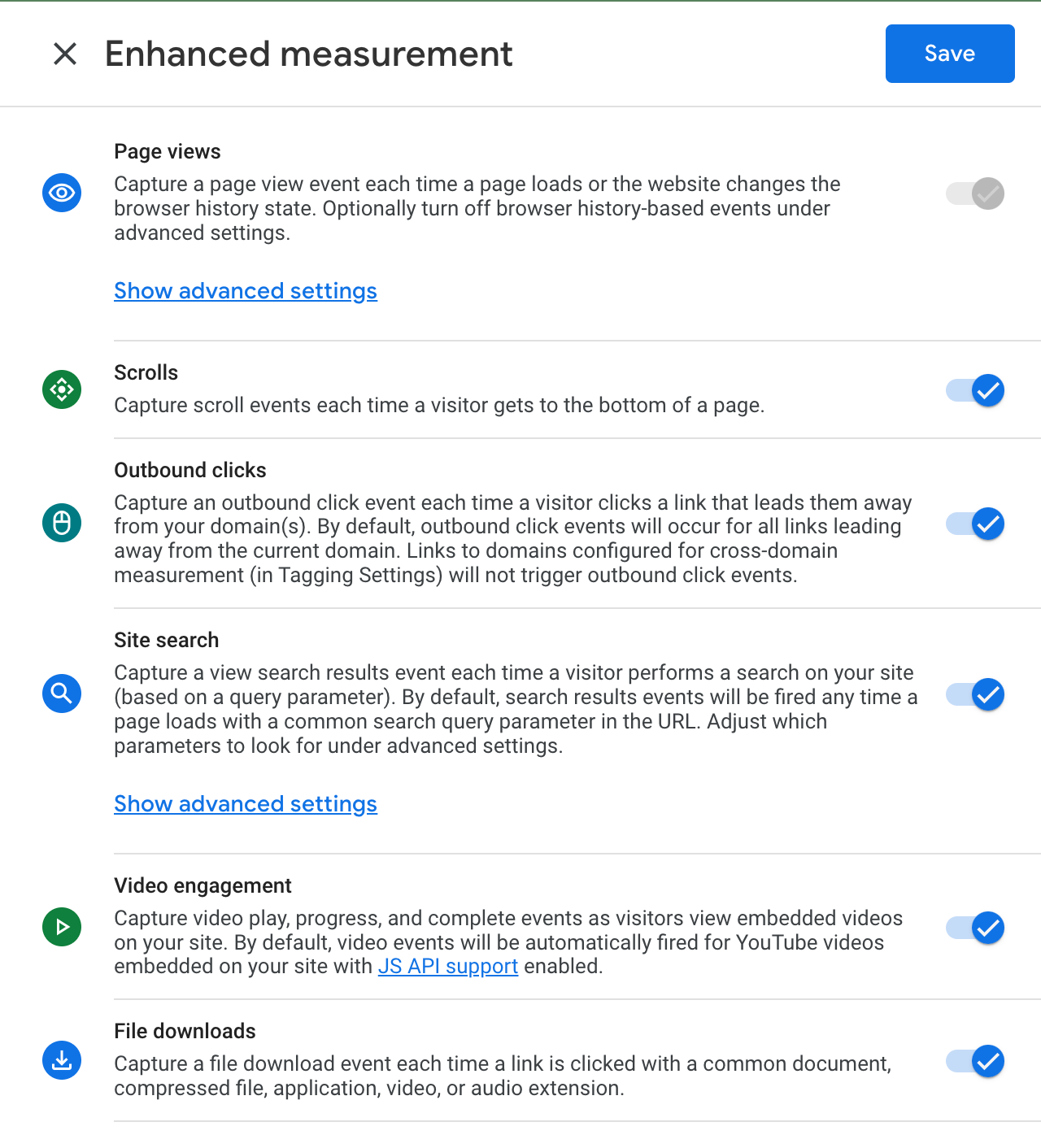 Every user action is now considered an event, even a Pageview, but there are now additional parameters attached to that event. In the example of a Pageview event, you now also get layers of parameters such as the Page Title and User Location attached to that PageView event.
Every user action is now considered an event, even a Pageview, but there are now additional parameters attached to that event. In the example of a Pageview event, you now also get layers of parameters such as the Page Title and User Location attached to that PageView event.
You can automatically track the following types of events in GA4, which did not feature in UA:
File downloads
Video engagement
Site Search Tracking
Outbound clicks
Scroll tracking
You can have up to 25 Custom Parameters per Event as well as the automatically collected Enhanced Measurement events (both captured via a Google Tag Manager implementation).
The differences in the Event structures:
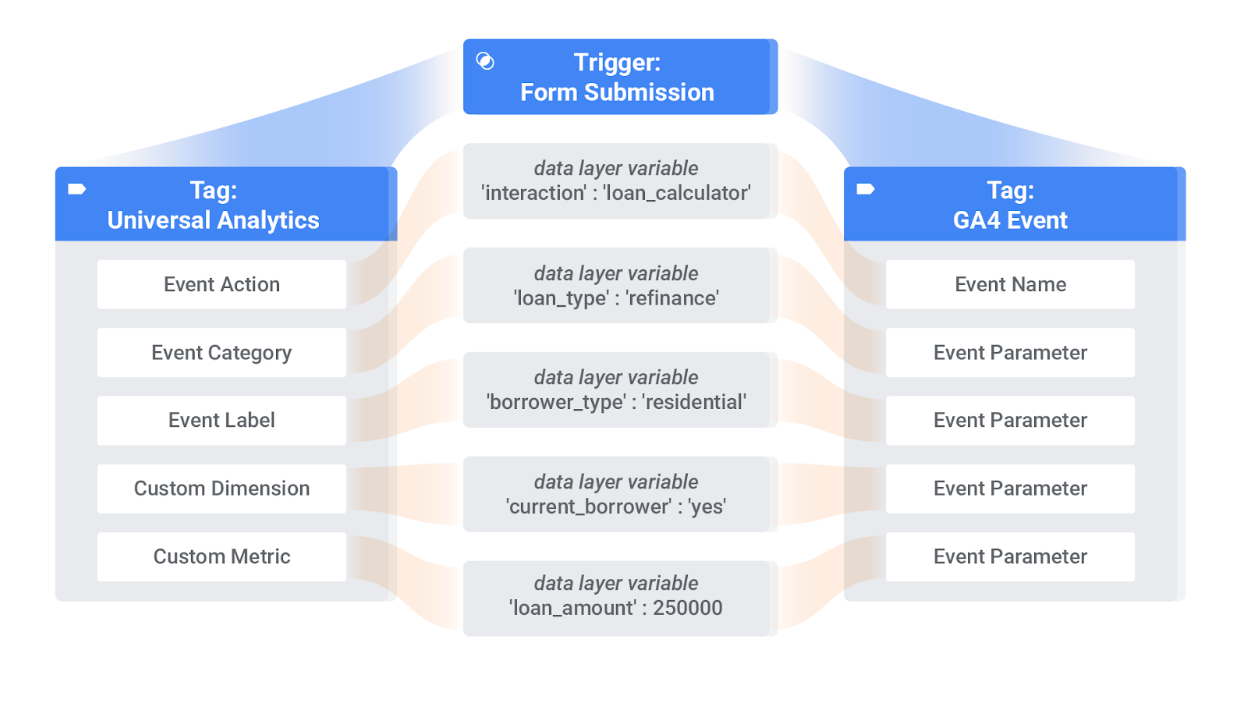 Site Search Tracking
Site Search Tracking
A feature of Enhanced Measurement in GA4 is Site Search tracking.This enables you to track the Search Queries a user enters when using your on-site search, if your website has one. This data will be invaluable when forming insight and directing updates to your websites UX, UI and content.
 DebugView
DebugView
DebugView is a useful feature of Tag Manager not visible in Analytics, until GA4. This feature enables you to view users' engagement with your site, in real time, so that you can check and troubleshoot your tracking set up using your device and browser before publishing changes to the live environment.
To use this feature you will need to use Tag Manager and enable the Google Analytics Debugger extension.
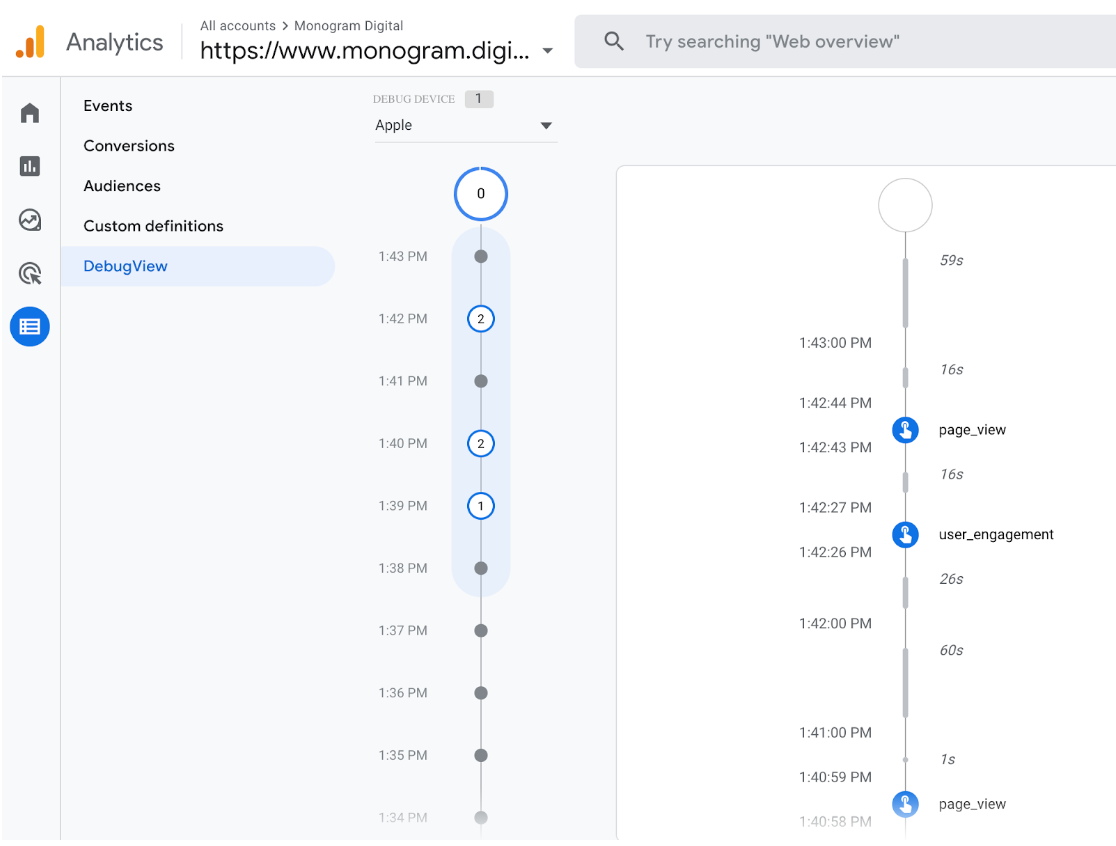 Engagement Metrics
Engagement Metrics
There is a significant difference between the key metrics displayed in GA4 and UA. Bounce Rates, Sessions, and Exit Rates etc have been replaced by Engaged Sessions, Engagement Rates, Engaged Sessions Per User and so on. This is intended to give you more meaningful insight into the performance of your website or app, with greater accuracy than the Page Views and Bounce Rates metrics used in UA.
 Free connection to BigQuery
Free connection to BigQuery
For agencies and more data driven in-house marketing teams, GA4 now comes with a free integration with Google BigQuery, so you can more easily interrogate the raw data. This was previously only available on GA360.
More complex Conversion tracking
Within UA you can only define a conversion based on a single parameter. For example, page views, single events, duration or number of page views per session.
You could not create a conversion based on multiple parameters such as “A user who came to your website from a referral such as Nike.com, used your in-site search and then purchased a pair of trainers above £75.”
Within GA4 however, you can do just that. If you sell trainers. And Nike are kind enough to send traffic your way.
This can be achieved by creating a new audience with the relevant conditions, i.e. came to your website from Nike.com and used the in-site search. Then create an audience trigger (a purchase is made with a value greater than £75) that logs when a user becomes a member of your audience. This audience trigger can then be marked as a conversion.
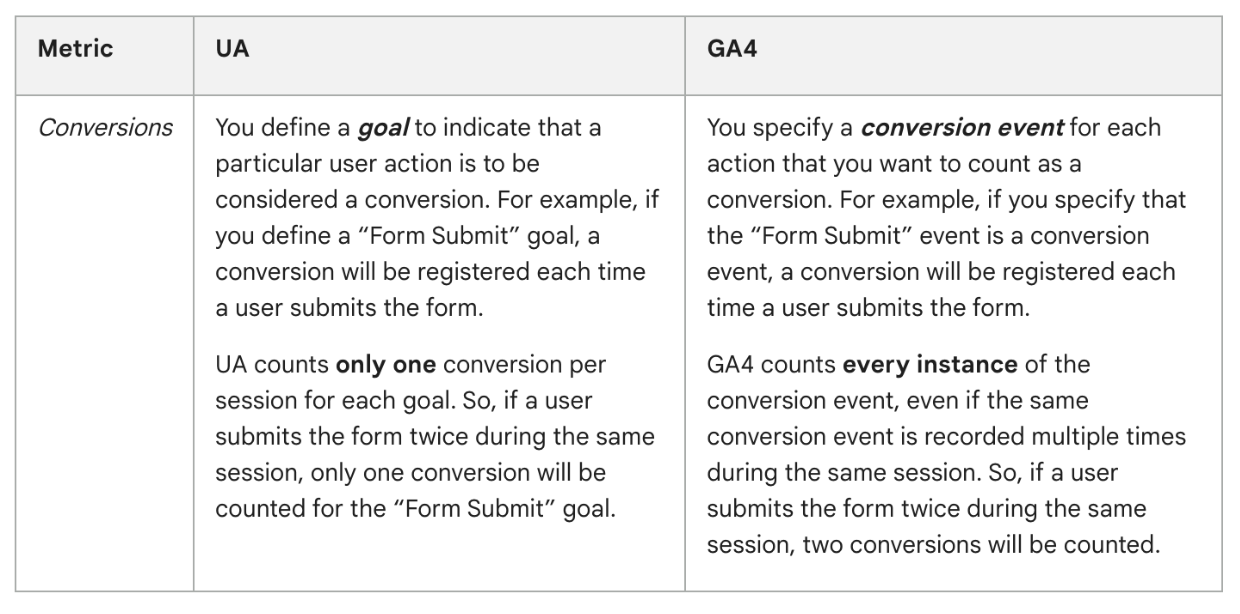 Session and Engagement tracking
Session and Engagement tracking
It is common behaviour for a user to open multiple tabs while browsing the internet and your website, with the intention of coming back to those tabs later in the day.
For example:
A user visits the homepage of your website
then jumps to another tab they have opened in their browser
1 hour later they come back to your homepage
read some content and close the tab without navigating any further on your site.
Within such a scenario UA would register the homepage visit as a Page View with 100% bounce rate. GA4 however would count 2 Views. One with just a View event, and the second View Event would include a User Engagement (page scroll).
It is also worth noting that both App and Web Page Views will be counted together under Views.
![]() For SEO and content specialists, this shift will change the game slightly, as Bounce and Exit rates are considered a key signal for website and content health by Search rankings.
For SEO and content specialists, this shift will change the game slightly, as Bounce and Exit rates are considered a key signal for website and content health by Search rankings.
Predictive Audiences
Using machine learning GA4 is now able to predict audiences based on user behaviour. These audiences can be used to help forecast revenue generation in the coming months, populate audiences for use within Google Ads, feed into CRM tools and more.
These audiences currently focus on User Churn Probability, Purchase Probability and Revenue Predictions.
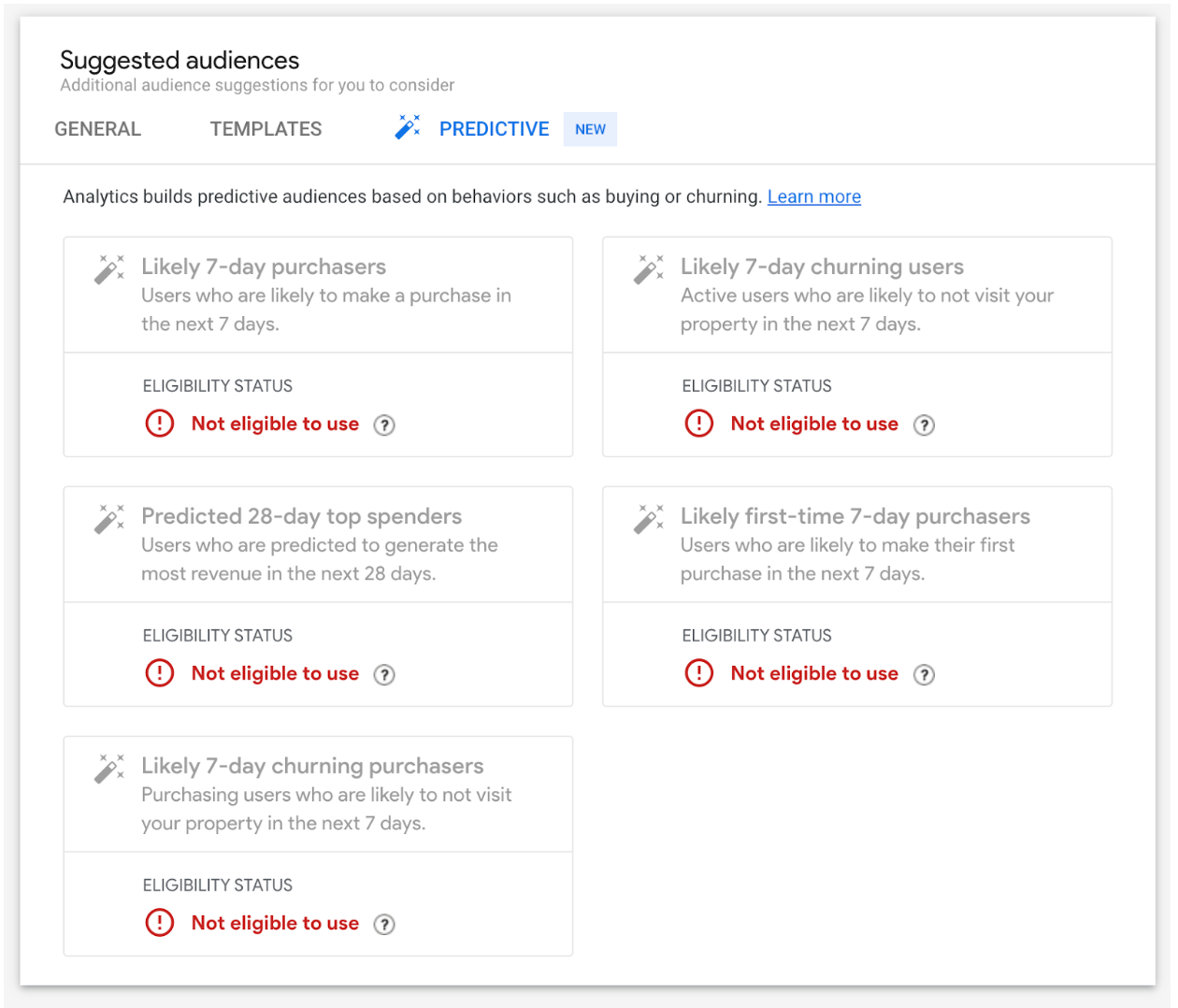 Upgraded funnel creation and analysis capabilities
Upgraded funnel creation and analysis capabilities
Explore is a new section of GA4 focused on giving you a deeper insight into your users and their journeys. GA4 introduces data and reporting techniques previously only seen in Analytics 360 and Firebase, and upgrades on those too.
Audience sharing with Google Ads
With the integration of GA4 and Google Ads Manager accounts you can share audience lists for retargeting, including the new predictive audience lists generated by GA4.
Google Ad Manager traffic will also be displayed within your GA4 account accompanied by the following dimensions and metrics as standard.
Dimensions
Ad format (uses value of Ad Manager Inventory Format dimension)
Ad source (uses Ad Manager network name and ID)
Ad unit (uses value of Ad Manager Ad unit (all levels) dimension)
Page path + query string and screen class (uses placement of Ad Manager ad units)
Metrics
Ad unit exposure (Amount of time a user is exposed to ads)
Publisher ad clicks (Ad Manager clicks)
Publisher ad impressions (Ad Manager impressions)
Total ad revenue (Sum of all advertising revenue, i.e., Ad Manager revenue + other ad revenue)
Key considerations when adopting GA4
Reporting & Marketing tech stack
Depending on your current set up, you may need to make some updates to your current data and reporting set up. GA4 is compatible with the same reporting tools as UA (BigQuery, Data Studio, DataBox, Tableau etc), so you will not need to change the tools you use, but re-configure some of the data points.
Event setup
As mentioned above, one of the key differences between GA4 and UA is the event and goal structure. This will require some thought and re-mapping, not only to match what you are currently tracking, but also to take advantage of GA4’s capabilities and additional event tracking to help better understand your users and site performance.
This consideration is even more important for e-commerce businesses, so time and resource should be allocated to work through this thoroughly during the set up.
Timing
The time to implement GA4 is now.
Conclusion
As with all new technology updates or adoptions, there will need to be sufficient time, resource and training allocated to ensure an effective implementation.
In the case of GA4 though, you can work through the set up without having to immediately switch from the familiar UA. This allows you time to complete the set-up and adoption without a big scary switch over day, the process can be gradual and you'll always have UA to look back on until July 2023. The key is to take advantage of the time we have between now and July 2023, leave it too late and you will have gaps in your data, need to rush the implementation, and have a big scary switch over day before your business can become fully accepting of GA4.
The sooner you switch, the sooner you can start taking advantage of all the new features within GA4 as well. It is a significant update and your entire business will enjoy the benefits and thank you for it for years to come!
For questions and support with your implementation and adoption of GA4, please get in touch for a free consultation.
